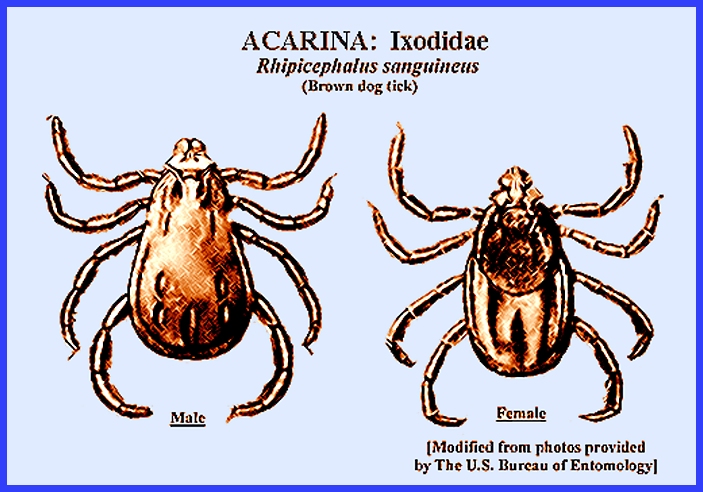File: <mediterraneanspottedfever.htm> <Medical Index> <General Index> Site Description Glossary <Navigate
to Home>
|
MEDITERRANEAN SPOTTED FEVER (Contact) Please
CLICK on
underlined links for details:
A sore
develops after infection that has been named tache noire., which later is followed by a
lymphadenitis. The main
vector is the dog tick, Rhipicephalus sanguineus,
but Matheson (1950) also includes Haemaphysalis leachi and Amblyomma hebraeum
as vectors. Infections in humans and
animals are by the bite of the tick, and both transstadial and transovarial
transmission occur. Reservoir hosts
are the ticks, dogs and rodents.
Crushing an infected tick into a wound or near the eyes can result in
infection. = = = = = = = = = = = =
= = = = = = = = Key References: <medvet.ref.htm> <Hexapoda> Camicas, J. L., J. . Hervy, F. Adam & P. C.
Morel. 1998. The ticks of the world (Acarida,
Ixodida): Nomenclature, Described
Stages, Hosts, Distribution. Paris: Editions de
l'ORSTOM. Gammons, M. & G. Salam. 2002.
Tick removal. Amer. Fam.
Physician 66: 643-45. Hoogstraal, H. 1966.
Ticks in relation to human diseases caused by viruses. Ann. Rev. Ent. 11: 261-308. Hoogstraal, H. 1967.
Ticks in relation to human diseases caused by Rickettsia species. Ann. Rev. Ent. 12: 377-420. Matheson, R. 1950. Medical Entomology. Comstock Publ. Co, Inc. 610 p. Parola, P. & D. Raoult. 2001.
Tick-borne typhuses. IN: The Encyclopedia of arthropod-transmitted
Infections of Man and Domesticated Animals.ed. M. W. Service, Wallingford:
CABI: pp. 516-24. Service, M. 2008.
Medical Entomology For Students.
Cambridge Univ. Press. 289 p Legner, E. F. 1995. Biological control of Diptera of medical and veterinary
importance. J. Vector Ecology 20(1):
59_120. Legner, E. F. 2000.
Biological control of aquatic Diptera. p. 847_870.
Contributions to a Manual of Palaearctic Diptera, Vol. 1, Science Herald, Budapest. 978 p. Sonenshine, D. E. &
T. N. Mather (eds.) 1994. Ecological Dynamics of Tick-Borne
Zoonoses. Oxford Univ. Press, New
York. Steer, A., J. Coburn & L. Glickstein. 2005.
Lyme borreliosis. IN: Tick-Borne Diseases of Humans, ed. J. L.
Goodman, D. T. Dennis & D. E. Sonenshine. Washington, DC: ASM Press |
